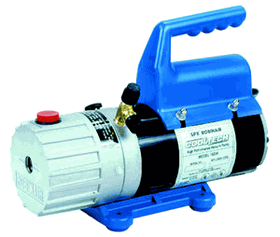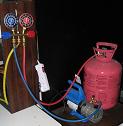|
High Vacuum Pumps
For high vacuums in the sub-microTorr range you will need a three
stage pumping system that will cost as much as an economy car.
The first stage is a "roughing pump" that
takes the chamber from atmosphere down to the milliTorr range. The
next stage (closer to the vacuum chamber) is a "diffusion pump"
that boils oil into a vapor and in a cooled section the oil rain
traps gases which can then be removed by the roughing pump. The
third stage is a "cold trap" which is just chamber off
the main vacuum chamber cooled by liquid nitrogen or liquid helium.
Any remaining gases freeze to the walls of this chamber.
The pump down starts with roughing as far as it will
go then turning on the diffusion pump and letting get as much of
the remaining gas in the chamber. This can take hours. Just before
an experiment the cold trap is filled to take the vacuum down to
minimum the apparatus can achieve.
A nice little article on a high vacuum system
from the UC Berkeley Microlab site is
here.
Medium Vacuum Pumps
Plasma work typically needs 1 to 10 Torr so you can
just use just about any vacuum pump or compressor to reach that
vacuum including some hand pumps.
A roughing pump for a vacuum system will cost you
about $1000 and probably need its own circuit breaker. It is probably
overkill for a small plasma lab but if you can get one cheap as
a surplus unit it will probably last forever. If you find a used
pump make sure it has never been run without pump oil. Like a car
engine it only takes a short while for the pump surfaces to become
scratched if they are not well oil. Repairing a damaged roughing
pump will cost you as much as buying a new one (think engine job).
At the low end are hand pumps (for those who want
forearms like Popeye) and scavenged compressors. Some (not all)
refrigerators and air conditioners have compressor units that can
be run as vacuum pumps. In general newer appliances have cleaver
designs that work fine as refrigerators but cannot be used as a
vacuum pump. Do not buy a new A/C from WallMart and pull the compressor
out expecting to get a vacuum pump. You will have more success twenty
year old unit collecting dust in someone's basement you can get
for free. For the ecofriendly removing the compressor will release
Freon which damages the planetary ozone shield. See if you can get
a repair shop to recycle the Freon for you.
The problem with using compressor is that pump a
pitifully small volume and you will need to put fittings on the
flimsy tubing to make them useful. It is very likely you will invest
a lot of time making the thing work and spend even more time as
you suffer with reliability problems trying to keep the thing working.
Automotive A/C Maintenance Pumps
The best price/performance for the home inventor is
a vacuum pump used in the auto repair business to replace the Freon
in automobile air conditioners. Car A/Cs run in pretty rough conditions
and moisture can get into the Freon because of imperfect seals and
large hot/cold cycles. This moisture combines with the degraded
Freon to make an acid that eats away at the metal A/C tubing.
When you get your car A/C repaired they suck out the
acidic Freon and vacuum test the system looking for leaks. The pumps
they use are rated at 50 milliTorr and may go lower to achieve that
rating. The pumps are designed to be portable and take a fair amount
of abuse so they are ideal for a small lab. If get a new pump or
a well maintained used pump and you keep a proper oil level it should
last forever with practically zero trouble.
My pump is a Robinair 15234 which pumps 1.2 cubic
feet per minute and consumes about 2 amps when struggling with a
maximum vacuum in the chamber. A fact sheet from Robinair for my
class of pump is
here. There are many other manufacturers of these pumps: CPS,
Mastercool, Mountain are other major brands. Low volume pumps like
mine cost from $150 to $400 new and Robinair is typically the more
expensive. I got mine used but in extremely good shape for $100.


Using a 4" PVC end cap vacuum chamber my Robinair
1.2 CFM pump achieved a full vacuum in very quick 25 seconds. For the rest of the
vacuum system continue reading on the "Vacuum Chambers"
link.
|

